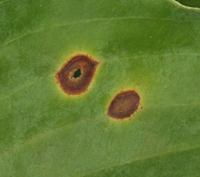|
 |
|
 |
|
 |
|
 |
 |
 As the name implies, these diseases
result in the formation of spots or blotches on plant
leaves. Some are circular and others will be irregular
or blotchy in form and of various sizes and placement on
the leaf. These specifics will help in the
identification of the specific disease involved. As the name implies, these diseases
result in the formation of spots or blotches on plant
leaves. Some are circular and others will be irregular
or blotchy in form and of various sizes and placement on
the leaf. These specifics will help in the
identification of the specific disease involved.
|
 |
|
 |
 |
|
Typical of plant problems, many leaf
spot diseases are specific to a genus and may not occur
on any others. There are also several organisms
including fungi, bacteria and insects as well as
environmental factors that can cause spots on leaves.
-
Fungal Leaf Spot: Spots
caused by fungi are often small and circular and may
be found on all the leaves. Sometimes only the older
or younger leaves
are affected. The spots range in size from barely
visible to ¾ inch in diameter. They may be yellow, red,
tan, gray, brown, or black and often have a definite
margin. Spots sometimes join together to form
blotches. Often the leaves turn yellow
and die. Infection is usually most severe during moist,
mild weather (50° to 85°F).
-
 Bacterial Leaf Spot:
Much less common than fungal leaf spots, a few
bacteria also cause spots on ornamental plants. The
symptom on the leaf is usually a circular lesion
with a "halo" of lighter colored tissue around it. Bacterial Leaf Spot:
Much less common than fungal leaf spots, a few
bacteria also cause spots on ornamental plants. The
symptom on the leaf is usually a circular lesion
with a "halo" of lighter colored tissue around it.
-
Insects: Critters that
feed on the top layer (epidermis) of the leaf often
leave damage in a spot-like manner.
Lacebugs,
leafhoppers,
spider mites,
plantbugs and
thrips all
leave damage signs that appear as spotting on plant
leaves.
Perhaps the most common damage is done by the four
lined plant bug which infests many
herbaceous
perennials. This true bug has a circular mouth and
it takes a roundish bite of the epidermis of leaves.
Its spittle is phytotoxic and kills the surrounding
tissue leaving a black spot. Several individual
spots will sometimes spread together making it look
like a larger blotch. To the uninitiated, the damage
looks like some type of leaf spot disease rather
than insect feeding.
-
Physical Damage: Leaves
may be damaged by excessive, hot sun or by cold
temperatures. Sunburn and frost damage may both
present themselves as spots on the leaves. Both kill
individual cells in the leaf and, if enough are
killed, they may form together into larger blotches.
|
 |
 |

|
-
Resistance - Some
species and cultivars within a genus may be less
susceptible or may be resistant to leaf spot
diseases.
-
Water - Most leaf
spot diseases are fungal which means that they
can be encouraged by providing the moist or wet
environment needed for the fungus to grow and
reproduce. So, for plants that are susceptible,
avoid watering onto the foliage in late
afternoon or evening so that the foliage goes
into the night wet. Also, provide plenty of air
movement around such plants to allow them to dry
faster after rain or dew.
|
 |
 |

|
|
|
 |
|
Note: We
have provided some general information and
observations on this topic aimed at the home
gardener. Before you take
any serious action in your landscape, check
with your state's land grant university's
Cooperative
Extension
Service for the most current,
appropriate, localized recommendations. |
|
 |
|



